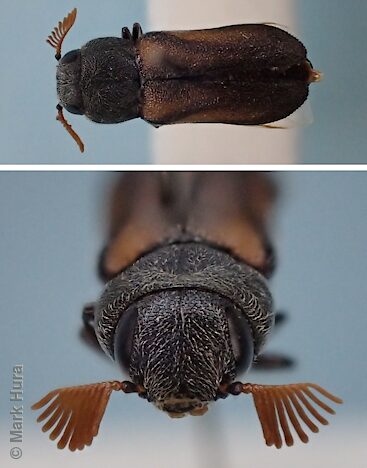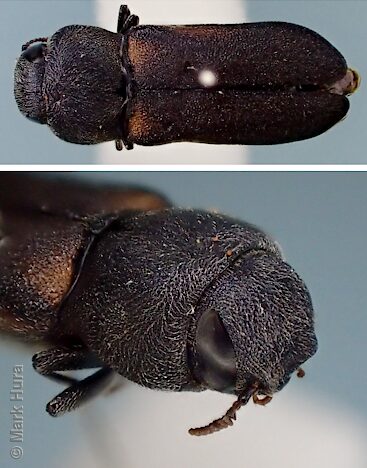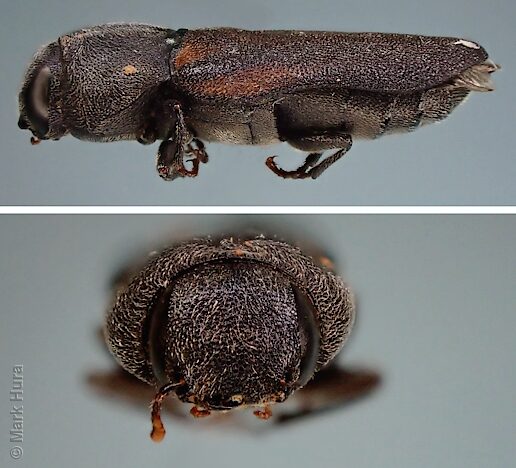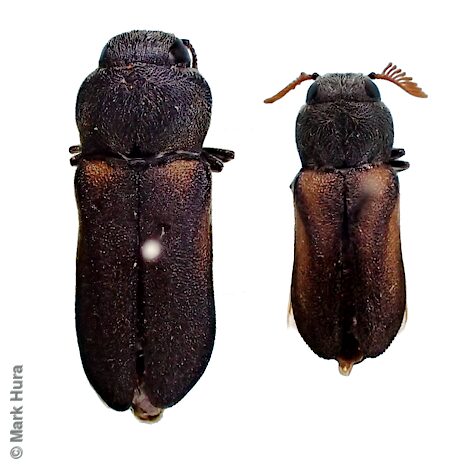



size¹:
×
2.6 mm




| male | ||||||
|---|---|---|---|---|---|---|
| L1 | 6.5 | n = 1 | ||||
| L2 | 6.3 | n = 1 | ||||
| W | 2.5 | n = 1 | ||||
| Legend | L1 | length from clypeus/frons to elytral apex (mean, range, sample size) |
| L2 | length from anterior of edge of eyes to elytral apex | |
| W | maximum width with elytra fully closed |
Antennae sexually dimorphic: pectinate (comb-like) in the male and serrate in the female; small size overall (5 to 6 mm long); eyes small, narrow, and not reaching pronotum; tarsi similar in length to tibiae and with reduced pulvilli (pads); labrum (upper lip) concealed under clypeus.
The suffix rhipis is from the Greek for 'a fan' and refers to the pectinate antennae which are rare in the Buprestidae. Bellamy 1986 compared Australorhipis to four interrelated New Word genera that share this feature, but he regarded it as being probably more closely related to Notographus (q.v.).
The genus and species were described by Bellamy 1986 based on a collection of two males and three females from near Fowlers Gap in the arid north-west of NSW. Lawrence & Lemann 2019 reported this type series to be the only known occurrence.
However, Lawrence 1997 reported at least two individuals which he identified as 'Australorhipis ?aphanochila' trapped on Calperum Station (MU Region) for the periods Nov–Dec and Dec–Jan.
The male and female specimens illustrated above are new records discovered by Mark Hura in the arid zone of SA. They were caught in a flight intercept trap set from 11 December 2017 to 7 January 2018.
| Legend | P.J.Lang collection vouchered records | |
| other private collection or museum specimens, or sightings |
Both the NSW and the EP (SA) collections were made using traps (pitfalls containing liquid, and a flight intercept trap respectively), and provide no information on plant hosts. The MU (SA) record is from a CSIRO study which employed a variety of trapping methods over a 12 month period at single sites in 5 major habitat types. An indication of potential plant hosts is provided by the fact that the Australorhipis came only from one site which was dominated by Casuarina pauper woodland with a sparse understory of Senna, Eremophila, Maireana sedifolia on calcareous substrate, and was absent from the other four habitats comprising three different mallee communities and a chenopod shrubland.
| ¹ Legend | regions | SA State Herbarium regions (map) EA: Eastern, EP: Eyre Peninsula, FR: Flinders Ranges, GT: Gairdner-Torrens, KI: Kangaroo Island, LE: Lake Eyre, MU: Murray, NL: Northern Lofty, NU: Nullarbor, NW: North-Western, SE: South-Eastern, SL: Southern Lofty, YP: Yorke Peninsula |
| size | The ellipse is the correct size when printed, indicative on a desktop screen, and likely to be wrong on a mobile device. |